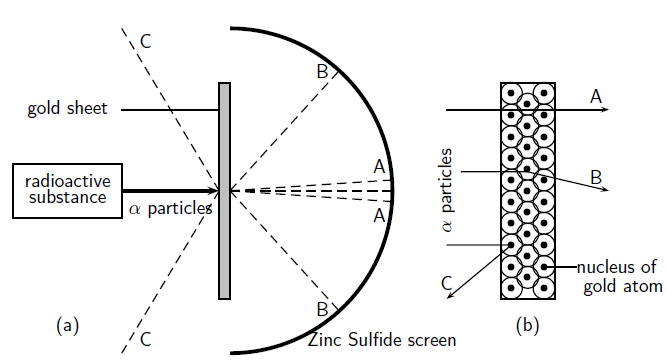| << Chapter < Page | Chapter >> Page > |

The discovery of radiation was the next step along the path to building an accurate picture of atomic structure. In the early twentieth century, Marie Curie and her husband Pierre, discovered that some elements (the radioactive elements) emit particles, which are able to pass through matter in a similar way to X-rays (read more about this in Grade 11). It was Ernest Rutherford who, in 1911, used this discovery to revise the model of the atom.
Radioactive elements emit different types of particles. Some of these are positively charged alpha ( ) particles. Rutherford carried out a series of experiments where he bombarded sheets of gold foil with these particles, to try to get a better understanding of where the positive charge in the atom was. A simplified diagram of his experiment is shown in [link] .

Rutherford set up his experiment so that a beam of alpha particles was directed at the gold sheets. Behind the gold sheets was a screen made of zinc sulphide. This screen allowed Rutherford to see where the alpha particles were landing. Rutherford knew that the electrons in the gold atoms would not really affect the path of the alpha particles, because the mass of an electron is so much smaller than that of a proton. He reasoned that the positively charged protons would be the ones to repel the positively charged alpha particles and alter their path.
What he discovered was that most of the alpha particles passed through the foil undisturbed and could be detected on the screen directly behind the foil (A). Some of the particles ended up being slightly deflected onto other parts of the screen (B). But what was even more interesting was that some of the particles were deflected straight back in the direction from where they had come (C)! These were the particles that had been repelled by the positive protons in the gold atoms. If the Plum Pudding model of the atom were true then Rutherford would have expected much more repulsion, since the positive charge according to that model is distributed throughout the atom. But this was not the case. The fact that most particles passed straight through suggested that the positive charge was concentrated in one part of the atom only.
Rutherford's work led to a change in ideas around the atom. His new model described the atom as a tiny, dense, positively charged core called a nucleus surrounded by lighter, negatively charged electrons. Another way of thinking about this model was that the atom was seen to be like a mini solar system where the electrons orbit the nucleus like planets orbiting around the sun. A simplified picture of this is shown in [link] . This model is sometimes known as the planetary model of the atom.

Notification Switch
Would you like to follow the 'Chemistry grade 10 [caps]' conversation and receive update notifications?